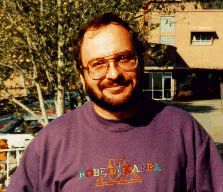
 Physics professor Spyridon Margetis has been working with physics from all over the globe on two major international experiments. ( Courtesy of Spyridon Margetis) |
Margetis has been involved with particle research since begining
David Tollon
STAFF REPORTER
Scientists from institutes in over 20 countries have participated in the particle experiments, including one from Kent State.
Assistant physics professor Spyridon Margetis has been involved in the particle research, experiment NA-49, at CERN since the inception of the testing.
Margetis' current research involves collisions of heavy nuclei at very extreme energies. He studies the behavior of this nuclear matter under excessive conditions of temperature and density.
His research is also being tested at the Relativistic Heavy Ion Collider, RHIC, in Long Island, New York. Margetis has been a major contributor to the creation of the RHIC experiment STAR. "My work at STAR is related to my research with CERN," Margetis said. "I have contributed research for CERN concerning strange particle production from lead beams." A particle is called "strange" if one of its constituent quarks is the strange quark. Ordinary matter contains only "up" and/or "down" quarks. When "strange" quarks appear, theoretically, a quark-gluon plasma may be present. "We examine signals looking for evidence that strange quarks appear when these extreme collisions occur," Margetis said. "We actually obtained the first major correlation between quarks and strange quarks at CERN."
Margetis said that a graph shows a linear correlation, straight line, between quarks. The "strange" quarks can be seen as a drop off of the line. These breaking points indicate evidence of the quark-gluon plasma. "The expectation is that if you create a quark-gluon plasma, the protection of these particles will be many times than that if you don't have a plasma," Margetis said. "We had several experiments that said we had it, as the strangeness protection was greatly enhanced."
Margetis' research is one section of experiments that led physicists at CERN to believe that they were, indeed, obtaining remarkable results. ºHe said that visualizing the results is an extension of our senses. "We are able to see what we normally cannot," Margetis said. "It's like looking at a picture of the evening sky. We see one picture, but if we use UV film, we will see a completely different picture." Margetis is also contributing to the software component of the experiments.